 | Throughout this book we have been using the Acme Travel Agency as a case study to illustrate many concepts of .NET. In this section we look at a Web site for the Acme Travel Agency. The code for the Web site is in the AcmeWeb directory in three progressive versions: Step0, Step1, and Step2. Step0 corresponds to our Visual Studio .NET demonstration from the preceding section. (A final step, discussed later in the chapter, is a database version of the case study. We deliberately avoid the database during most of the chapter, so as not to distract focus from the core Web programming topics.) | In this section we will give an overview of the case study, and in the next we will discuss some more details about Web applications, using the case study as an illustration. Configuring the Case Study  | Links are provided to the three steps of the case study on the ASP.NET example programs "home page" for this chapter, which you can access through the URL http://localhost/Chap14/ . To be able to run the Web applications, you must use IIS to configure the directories AcmeWeb/Step0 , AcmeWeb/ Step1 , AcmeWeb/Step2 as Web applications. Follow the instructions provided in the previous section. If you want to experiment with any of the versions in Visual Studio, you can double click on the .vbproj file to create a Visual Studio solution. | Acme Web Site Step 1 In Step 1 we provide a simple two-page Web site. In the first page you can make reservations, and in the second you can manage your reservations . We have hard-coded the customer as "Rocket Squirrel," who has a CustomerId of 1. HotelReservations.aspx The start page for the application is HotelReservations.aspx . Figure 14-26 shows this page in Internet Explorer, after a reservation has been booked at the hotel Dixie in Atlanta. Figure 14-26. Hotel reservations page of Acme Web site. 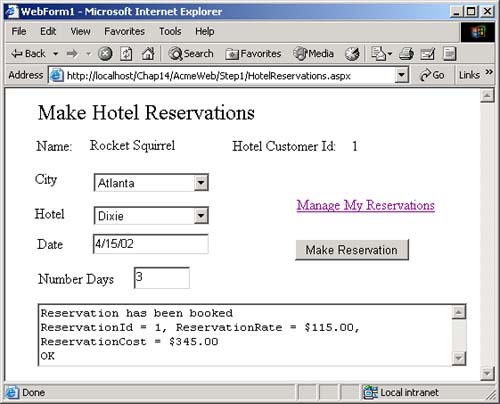 The code for initializing the DropDownList controls is the same as for Step 0, as is the code for handling the SelectedIndexChanged event for the City dropdown. The key new code is making a reservation. This code should have no surprises for you. It makes use of the HotelBroker class, which we already have instantiated for displaying the hotels. The design of the Web page enables a user to quickly make a number of reservations without leaving the page. We are relying on the postback mechanism of ASP.NET. When done making reservations, the user can follow the link "Manage My Reservations." ManageReservations.aspx The second page for the application is ManageReservations.aspx . Figure 14-27 shows this page in Internet Explorer, after reservations have been booked for Atlanta, Boston, and Chicago. Figure 14-27. Manage reservations page of Acme Web site. 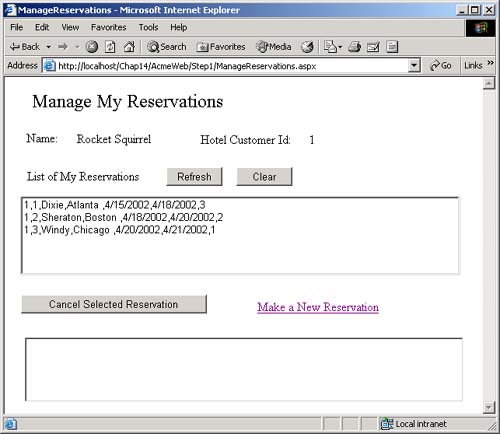 The user can cancel a reservation by selecting a reservation in the listbox and clicking the Cancel Selected Reservation button. A link is provided to the hotel reservations page. The code for this page is quite straightforward, making use of the capability to provide event handlers in a server-side control. Here is the code for a helper method to show the reservations in the listbox. This code is very similar to the Windows Forms code that we looked at in Chapter 7.  Private Sub ShowReservations() Dim id As Integer = _ Convert.ToInt32(lblHotelCustomerId.Text) Dim array As ArrayList = _ broker.FindReservationsForCustomer(id) If array Is Nothing Then Return End If ClearReservations() Dim item As ReservationListItem For Each item In array Dim rid As String = item.ReservationId.ToString() Dim hotel As String = item.HotelName Dim city As String = item.City Dim arrive As String = item.ArrivalDate.ToString("d") Dim depart As String = _ item.DepartureDate.ToString("d") Dim number As String = item.NumberDays.ToString() Dim str As String = id & "," & rid & "," & hotel & _ "," & city & " ," & arrive & "," & depart & "," _ & number listReservations.Items.Add(str) Next End Sub Private Sub ShowReservations() Dim id As Integer = _ Convert.ToInt32(lblHotelCustomerId.Text) Dim array As ArrayList = _ broker.FindReservationsForCustomer(id) If array Is Nothing Then Return End If ClearReservations() Dim item As ReservationListItem For Each item In array Dim rid As String = item.ReservationId.ToString() Dim hotel As String = item.HotelName Dim city As String = item.City Dim arrive As String = item.ArrivalDate.ToString("d") Dim depart As String = _ item.DepartureDate.ToString("d") Dim number As String = item.NumberDays.ToString() Dim str As String = id & "," & rid & "," & hotel & _ "," & city & " ," & arrive & "," & depart & "," _ & number listReservations.Items.Add(str) Next End Sub Acme Web Site Step 2 Step 2 is the full-blown implementation of our Web site case study. Acme customers do not interact with the Hotel Broker directly. Instead, they go through Acme's Web site. In order to use the Web site, a customer must register, providing a user ID, name , and email address. Subsequently, the user can log in by just providing the user ID. AcmeLIB Component Internally, Acme maintains a database of user IDs and corresponding Hotel Customer IDs. [4] The interface IAcmeUser encapsulates this database maintained by Acme. The class library project AcmeLib contains a collection-based implementation of such a database. The file AcmeTravelDefs.cs contains the definitions of interfaces and of a structure. [4] The Web site is Acme's, and Acme maintains user IDs for its own customers. Acme connects to various brokers (such as hotel and airline), and each broker will have its own customer ID.  ' AcmeTravelDefs.vb Imports OI.NetVb.Acme Public Interface IAcmeUser Function Login(ByVal uid As String) As Boolean Function Register(ByVal uid As String, _ ByVal firstName As String, _ ByVal lastName As String, _ ByVal emailAddress As String) As Boolean Function Unregister(ByVal uid As String) As Boolean Function ChangeEmailAddress(ByVal uid As String, _ ByVal emailAddress As String) As Boolean Function GetUserInfo(ByVal uid As String, _ ByRef info As UserInfo) As Boolean End Interface Public Interface IAcmeAdmin Function GetUsers() As ArrayList End Interface Public Structure UserInfo Public HotelCustomerId As Integer Public FirstName As String Public LastName As String Public EmailAddress As String End Structure ' AcmeTravelDefs.vb Imports OI.NetVb.Acme Public Interface IAcmeUser Function Login(ByVal uid As String) As Boolean Function Register(ByVal uid As String, _ ByVal firstName As String, _ ByVal lastName As String, _ ByVal emailAddress As String) As Boolean Function Unregister(ByVal uid As String) As Boolean Function ChangeEmailAddress(ByVal uid As String, _ ByVal emailAddress As String) As Boolean Function GetUserInfo(ByVal uid As String, _ ByRef info As UserInfo) As Boolean End Interface Public Interface IAcmeAdmin Function GetUsers() As ArrayList End Interface Public Structure UserInfo Public HotelCustomerId As Integer Public FirstName As String Public LastName As String Public EmailAddress As String End Structure Login will return True if uid is found. Register will register a new user with the Hotel Broker. Methods are also provided to unregister and change email address. These methods will call the corresponding methods of the ICustomer interface. GetUserInfo will return a UserInfo struct as a ByRef parameter. This structure defines an Acme user. The method GetUsers of the IAcmeAdmin interface returns an array list of UserInfo structures. The class Acme wraps access to the Customers class, whose methods get invoked indirectly through methods of IAcmeUser . The class Acme also contains a public member broker of type HotelBroker . Thus to gain complete access to the Hotel Broker system, a client program or Web page simply has to instantiate an instance of Acme . Here is the start of the definition of Acme . Public Class Acme Implements IAcmeUser, IAcmeAdmin Public broker As HotelBroker Private custs As Customers Private users As ArrayList Private currUser As User Public Sub New() users = New ArrayList() broker = New HotelBroker() custs = New Customers() InitializeUsers() End Sub ' Initialize users with data from Customers list Private Sub InitializeUsers() Dim arr As ArrayList = custs.GetCustomer(-1) Dim cust As CustomerListItem For Each cust In arr Dim uid As String = cust.FirstName Dim custid As Integer = cust.CustomerId Dim us As User = New User(uid, custid) users.Add(us) Next End Sub ... The class Acme also implements the interface IAcmeAdmin . Public Interface IAcmeAdmin Function GetUsers() As ArrayList End Interface The method GetUsers returns an array list of UserInfo . Login.aspx To get a good feel for how this Web application works, it would be a good idea for you to register and make a few reservations. You could then try logging in as another user. [5] You can start up the application through the ASP.NET Example programs home page, link to Acme (Step 2), or else directly enter the URL: [5] We are ignoring security considerations in this chapter. Security in ASP.NET will be discussed in Chapter 16. http://localhost/Chap14/AcmeWeb/Step2/Main.aspx The start page for the application is Main.aspx . If there is no currently logged-in user, the new user will be redirected to Login.aspx . We will examine the logic in Main.aspx shortly. For now, let's do the experiment of registering and logging in. Figure 14-28 shows the login page. In our implementation we offer "Rocket" as a possible user ID. Later you can quickly log in as "Rocket Squirrel" by simply clicking Login. But now click Register. Figure 14-28. Login page of Acme Web site. 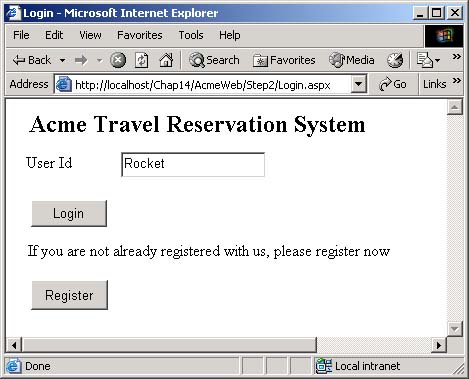 RegisterNewUser.aspx The "Register New User" page allows the user to pick a User ID and enter some identifying information (first name, last name, and email address). Figure 14-29 shows this page after "John Smith" has entered information for himself. When done entering information, the user should click Register, which will directly bring up the Acme Travel Agency home page, bypassing a need for a separate login. Figure 14-29. Register new user page of Acme Web site. 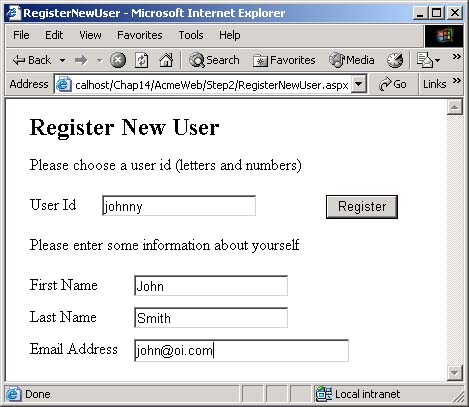 Main.aspx The home page of the Acme Web Site is Main.aspx. Figure 14-30 shows this home page for the user John Smith, who has just registered. A link is provided to "Login" as a different user, if desired. There are links for "Make a Hotel Reservation" and "Manage Your Reservations." These pages are the same as shown previously for Step 1. Figure 14-30. Home page of the Acme Web site. 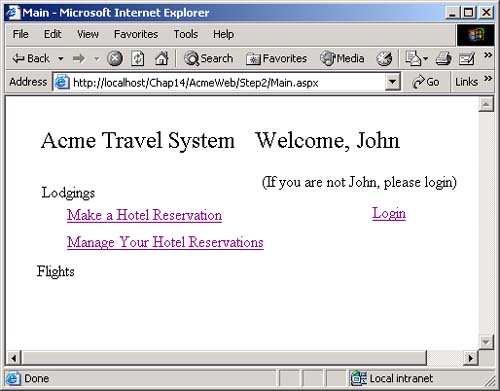  |